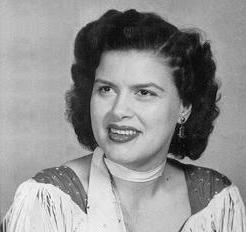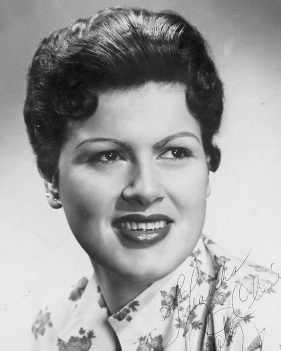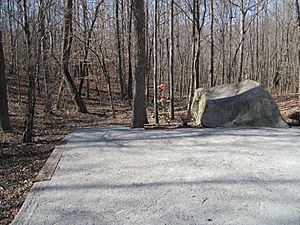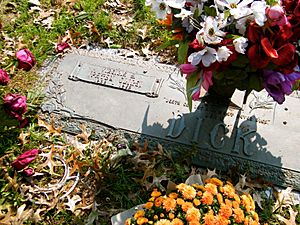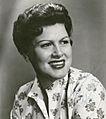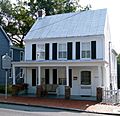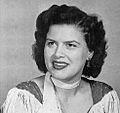Patsy Cline facts for kids
Quick facts for kids
Patsy Cline
|
|
|---|---|
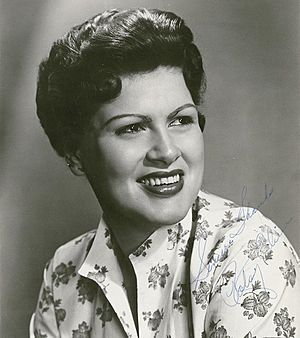
Publicity portrait for Decca Records, 1960
|
|
| Born |
Virginia Patterson Hensley
September 8, 1932 Winchester, Virginia, U.S.
|
| Died | March 5, 1963 (aged 30) Camden, Tennessee, U.S.
|
| Cause of death | Plane crash |
| Resting place | Shenandoah Memorial Park, Winchester |
| Occupation |
|
| Years active | 1948–1963 |
| Spouse(s) |
|
| Children | 2 |
| Musical career | |
| Genres | |
| Instruments |
|
| Labels |
|
Patsy Cline (born Virginia Patterson Hensley; September 8, 1932 – March 5, 1963) was a famous American singer. She is known as one of the most important singers of the 1900s. Patsy was one of the first country music artists to become popular in pop music. She had many big hits during her eight years of recording songs. Two of her songs reached number one on the Billboard country music charts.
Patsy Cline started performing professionally at age fifteen. She sang at a local radio station called WINC. In the early 1950s, she joined a local band led by Bill Peer. Her local shows led to performances on Connie B. Gay's Town and Country TV show. This also helped her get her first recording deal with Four Star in 1954. She had some small hits like "A Church, a Courtroom, Then Goodbye" (1955) and "I've Loved and Lost Again" (1956). In 1957, Patsy appeared on national TV for the first time. She was on Arthur Godfrey's Talent Scouts. After she sang "Walkin' After Midnight", it became her first big hit. It was popular on both country and pop music charts.
Patsy's later songs with Four Star Records were not as successful. But she kept performing and recording. In 1957, she got married and had a baby in 1958. She then moved to Nashville, Tennessee, to help her career grow. She worked with a new manager, Randy Hughes. Patsy became a member of the Grand Ole Opry and later signed with Decca Records in 1960. With producer Owen Bradley, her music style changed. She started having steady success. Her 1961 song "I Fall to Pieces" was her first to reach the top of the Billboard country chart. While this song was a hit, Patsy was badly hurt in a car accident. She had to stay in the hospital for a month. After she got better, her next song, "Crazy", also became a huge hit.
In 1962 and 1963, Patsy had more hits like "She's Got You", "When I Get Through with You", "So Wrong" and "Leavin' on Your Mind". She also went on more tours and headlined shows. In March 1963, Patsy Cline died in a plane crash. Country singers Cowboy Copas and Hawkshaw Hawkins also died in the crash, along with her manager Randy Hughes. They were flying from Kansas City, Kansas back to Nashville.
After her death, Patsy Cline has been called one of the most famous and respected singers of the 1900s. Her music has inspired many artists in different styles. She is also seen as a leader for women in country music. She was one of the first women to sell many records and headline concerts. In 1973, she was the first female singer to join the Country Music Hall of Fame. In the 1980s, Patsy's fame continued after her death. She was shown in two major movies. One was the 1985 movie Sweet Dreams starring Jessica Lange. Many documentaries and stage shows were also made. This included the 1988 musical Always...Patsy Cline. A special collection of her songs came out in 1991 and was highly praised. Her greatest hits album sold over 10 million copies by 2005. In 2011, Patsy's childhood home was fixed up. It became a museum for fans to visit.
Contents
Early Life and Musical Beginnings
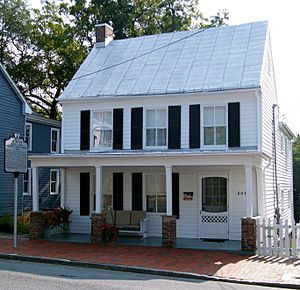
Patsy Cline was born Virginia Patterson Hensley in Winchester, Virginia. Her birthday was September 8, 1932. Her mother, Hilda Virginia, was only 16 when Patsy was born. Her father was Samuel Lawrence Hensley. Patsy had two older half-siblings who lived with another family. After Patsy, her mother had two more children, Samuel Jr. (called John) and Sylvia Mae. As a child, Patsy was often called "Ginny."
Her family moved many times across Virginia. Her father was a blacksmith and moved to find work. They lived in places like Elkton, Staunton, and Norfolk. When the family had little money, Patsy would find jobs. She once worked at a chicken factory, plucking and cutting chickens. The family finally settled in Winchester, Virginia, on South Kent Street.
At age 13, Patsy got a bad throat infection and rheumatic fever. She later said this illness changed her voice. "The fever affected my throat and when I recovered I had this booming voice," she explained. This is when she became very interested in singing. She started singing with her mother in the local Baptist church choir. They also sang duets at church events. Patsy also taught herself to play the piano.
Patsy's interest in singing grew even more. At 14, she told her mother she would try out for the local radio station. Her first radio performances were at WINC in Winchester. The radio DJ, Joltin' Jim McCoy, was impressed by her singing. He let her sing live on the air. While on the radio, Patsy also started entering talent contests. She also created a nightclub act.
Patsy's parents had problems, and her father left the family in 1947. Patsy had a very close bond with her mother. Her mother said they were "more like sisters." When Patsy started ninth grade at John Handley High School, her family needed money. So, Patsy left high school to help support them. She started working at Gaunt's Drug Store in Winchester. She was a clerk and made sodas.
Career Highlights
1948–1953: Early Singing Days
At 15, Patsy wrote a letter to the Grand Ole Opry asking for an audition. She sent it and later got a reply asking for pictures and recordings. Around the same time, Gospel singer Wally Fowler had a concert in her hometown. Patsy convinced workers to let her backstage. She asked Fowler for an audition. After a good audition, Patsy's family got a call. The Opry wanted her to audition. She traveled with her mother, two siblings, and a friend to Nashville, Tennessee. They drove all night and slept in a park because they had little money. Patsy auditioned for Opry singer Moon Mullican that day. The audition went well, and Patsy expected to hear back soon. But she never did, and the family went back to Virginia.
By the early 1950s, Patsy kept performing locally. In 1952, she tried out for local country bandleader Bill Peer. She then started singing regularly with Bill Peer's Melody Boys and Girls. Peer encouraged her to use a stage name. She changed her first name from Virginia to Patsy, from her middle name "Patterson." She kept her new last name, Cline. She became known as "Patsy Cline."
In August 1953, Patsy won a local country music contest. She won 100 dollars and a chance to perform regularly on Connie B. Gay's Town and Country Time. This show had country stars like Jimmy Dean and Roy Clark. It was filmed in Washington D.C. and Arlington, Virginia. Patsy's TV performances were praised. The Washington Star magazine said she had great stage presence. They noted her "throaty style loaded with motion and E-motion."
1954–1960: Four Star Records and First Hit
In 1954, Bill Peer made demo tapes with Patsy's singing. One tape got to Bill McCall, head of Four Star Records. On September 30, 1954, she signed a two-year recording deal with Four Star. This contract meant Patsy got very little money from her songs. She only received 2.34 percent of the earnings. Her first recording session was in Nashville, Tennessee in January 1955. Four Star then leased her recordings to Decca Records. Owen Bradley produced her sessions, and they worked together for many years. Her first song released was "A Church, a Courtroom, Then Goodbye" in 1955. Patsy promoted it on the Grand Ole Opry, but the song was not a hit.
Patsy recorded many types of music for Four Star. This included gospel, rockabilly, traditional country, and pop. Some music writers said the songs chosen for her were not very good. They felt Patsy was still trying to find her own sound.
Between 1955 and 1956, Patsy's songs for Four Star did not become hits. But she kept performing in her area. In 1956, she appeared on ABC's Ozark Jubilee. At one of her local shows, she met her second husband, Charlie Dick. In 1956, Patsy was asked to perform on Arthur Godfrey's Talent Scouts. This was a national TV show she had tried out for earlier. She accepted the offer. Her mother, Hilda Hensley, pretended to be her talent scout for the show.
Patsy and her mother flew to New York City in January 1957. Patsy appeared on the show on January 21. She wanted to sing "A Poor Man's Roses (Or a Rich Man's Gold)". But the show's producer preferred "Walkin' After Midnight". Patsy did not want to sing it at first, but she agreed. The producer also suggested Patsy wear a cocktail dress instead of her cowgirl outfit. Patsy sang "Walkin' After Midnight" and won the contest that night. The song had not been released yet. To meet public demand, Decca Records quickly released it on February 11. The song became Patsy's first big hit. It reached number 2 on the country charts and number 12 on the pop charts. This song is now a classic in country music.
The success of "Walkin' After Midnight" led to many TV appearances for Patsy. She continued working for Arthur Godfrey. She also appeared on the Grand Ole Opry and Western Ranch Party. She earned ten thousand dollars from these shows. Patsy gave all the money to her mother. Her mother used it to pay off the mortgage on their house in Winchester. In August 1957, her first album was released by Decca Records.
Patsy's next songs after "Walkin' After Midnight" were not successful. She was unhappy with this. Her producer, Owen Bradley, said she often felt like a "prisoner." Around this time, Patsy was fired from her regular spot on Town and Country Jamboree. In September 1957, Patsy married Charlie Dick. He was soon sent away for military duty. Patsy also had her first daughter, Julie. To restart her career, Patsy and her family moved to Nashville, Tennessee.
1960–1961: New Success and Car Accident
Patsy's career started to get much better by the early 1960s. After moving to Nashville, she signed a deal with manager Randy Hughes. He helped her get more steady jobs. He arranged shows for fifty dollars each. He also got her many performances on the Grand Ole Opry. In January 1960, Patsy officially became a member of the Opry. She signed with Decca Records in late 1960. She worked only with Owen Bradley. She asked for money upfront and received $1,000 from Bradley.
Her first song released under Decca was "I Fall to Pieces" in 1961. This song was written by Hank Cochran and Harlan Howard. Other singers had turned down "I Fall to Pieces" before Patsy recorded it in November 1960. At the recording session, she worried about the song's sound. She argued with Bradley about the background singers. They agreed she would record "I Fall to Pieces" (which Bradley liked) and "Lovin' in Vain" (which she liked). "I Fall to Pieces" was released in January 1961. It did not get much attention at first. But by August 7, it became her first song to top the country chart. It also became a pop hit, reaching number 12 on the Billboard Hot 100 chart.
On June 14, 1961, Patsy and her brother Sam were in a car accident. Their car was hit head-on by another vehicle. Patsy was thrown into the windshield. She had bad facial injuries, a broken wrist, and a dislocated hip. Her friend Dottie West rushed to help her. Patsy insisted the other driver be treated first. Two people in the other car died. When Patsy arrived at the hospital, her injuries were very serious. Doctors did not expect her to live. She had surgery and survived. She spent a month recovering in the hospital.
1961–1963: Career Peak and Final Years
Patsy returned to singing six weeks after her 1961 car accident. Her first public show was at the Grand Ole Opry. She told fans she would keep performing. She thanked them for their encouragement.
Patsy's next song after "I Fall to Pieces" was "Crazy". It was written by Willie Nelson. Patsy did not like the song at first. But Owen Bradley liked it. He convinced her to record it on August 17. Patsy listened to Nelson's version and decided to sing it differently. She removed a spoken part. It was hard for her to sing the high notes because her ribs still hurt from the accident. Bradley sent her home to rest. A week later, she came back and recorded her voice in one try.
"Crazy" was released in October 1961. It reached number 2 on the country charts. It also reached number 9 on the pop charts. "Crazy" became Patsy's biggest pop hit. Her second album, Patsy Cline Showcase, came out in late 1961. It had her big hits from that year.
"Crazy" is now a classic country song. Patsy's singing and the song's production are highly praised. Critics say her voice had a deep "ache" and "world weariness." This made the song special. Her voice sounded "richer, more confident, and more mature." Owen Bradley helped make her voice sound smooth and powerful.
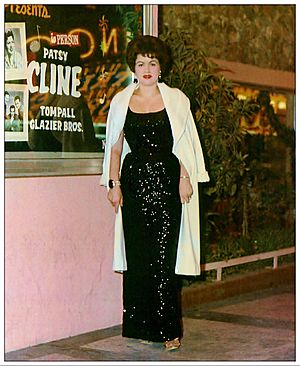
In November 1961, Patsy performed at Carnegie Hall in New York City. She was with other Opry stars like Minnie Pearl and Jim Reeves. The show sold out. By the end of 1961, Patsy won awards like "Favorite Female Vocalist" from Billboard Magazine.
In 1961, Patsy recorded "She's Got You". Hank Cochran wrote it. Patsy liked the song and recorded it on December 17, 1961. "She's Got You" became her third country-pop hit in early 1962. It was also her second number 1 hit on the Billboard country chart. It was Patsy's first song to chart in the United Kingdom.
In 1962, Patsy had three more hits: "When I Get Through with You", "So Wrong", and "Imagine That". Patsy's success helped her buy her first home. She bought a house in Goodlettsville, Tennessee, near Nashville. She called it her "dream home." She often had friends over.
In the summer of 1962, her manager Randy Hughes got her a role in a country music movie. But the producer ran off with the money, and the movie was never made. In August, her third album, Sentimentally Yours, was released. It included "She's Got You." Randy Hughes also arranged for Patsy to perform in Las Vegas, Nevada, for 35 days. Patsy did not like this experience. She got a dry throat and missed her children. But by performing there, Patsy became the first female country artist to headline her own show in Las Vegas.
During this time, Patsy told friends she felt she would die soon. Dottie West, June Carter Cash, and Loretta Lynn remembered her saying this. In January 1963, her next song "Leavin' on Your Mind" was released. In February, she recorded her last songs for Decca Records. These included "Sweet Dreams", "He Called Me Baby", and "Faded Love".
Personal Life
Friendships with Other Artists
Patsy Cline had close friendships with many country artists. Her friendship with Loretta Lynn is very famous. They met after Patsy's 1961 car accident. Loretta sang "I Fall to Pieces" on the radio. Patsy heard it and sent her husband to pick up Loretta. Loretta said they became close friends "right away." Loretta said Patsy taught her a lot about show business. Patsy even bought her clothes and things for her house. Loretta said Patsy was a "great human being and a great friend."
Dottie West was another close friend. They met backstage at the Grand Ole Opry. Dottie said Patsy showed real interest in her career. They often spent time at each other's homes and toured together. Dottie said Patsy was a supportive friend.
Jan Howard was a third close friend. They met backstage at the Grand Ole Opry. Patsy tried to start an argument with Jan, but then laughed and said they would be good friends. They stayed close for the rest of Patsy's life. Patsy was also friends with Brenda Lee, Barbara Mandrell, and Del Wood. She was friends with male artists too, like Roger Miller and Faron Young.
Family Life
Patsy's mother, Hilda Hensley, continued living in Winchester, Virginia, after Patsy's death. She lived across the street from their childhood home. Hilda helped raise Patsy's two children. Hilda kept many of Patsy's stage costumes. She was a seamstress and made many of her daughter's outfits. Hilda died in 1998.
Patsy's father, Samuel Hensley, died in 1956. He had left the family in 1947. Before he died, Patsy visited him in the hospital. She told her mother that even though he had done many things, she wanted to see him because he was very sick.
Patsy had two children: Julie Simadore and Allen Randolph "Randy." Julie has worked hard to keep her mother's memory alive. She attends many events to support her mother's music. After her father died in 2015, Julie helped open a museum for Patsy in Nashville, Tennessee. Julie has few memories of her mother because Patsy died when she was young. But Julie said she understands her mother's important place in music history.
Marriages
Patsy Cline was married two times. Her first marriage was to Gerald Cline on March 7, 1953. They met while she was performing with Bill Peer. Gerald Cline said it was "love at first sight" for him. He often took her to her concerts. But he found it hard to get used to her touring schedule. Patsy and Gerald started living apart in late 1956 and divorced in 1957.
Patsy married her second husband, Charlie Dick, on September 15, 1957. They met in 1956 when Patsy was singing with a local band. Charlie worked for a local newspaper. Patsy told a friend she was "in love, and this time, it's for real." They had two children, Julie and Randy. Their relationship was loving but also had arguments.
After Patsy's death in 1963, Charlie married Jamey Ryan in 1965. They later divorced. Charlie helped keep Patsy's legacy alive for the rest of his life. He helped make documentaries about her career. Charlie Dick died in 2015 and was buried next to Patsy.
Death
On March 3, 1963, Patsy Cline performed a benefit concert. It was for the family of a disc jockey who had died in a car crash. The concert was in Kansas City, Kansas. Other singers like George Jones and Dottie West also performed. Patsy had a cold but still gave three shows. All the shows were completely full. Her last song was "I'll Sail My Ship Alone."
Patsy stayed at a motel after the concert. She could not fly out the next day because of fog. Dottie West offered Patsy a ride back to Nashville, which was an 8-hour drive. But Patsy refused, saying, "When it's my time to go, it's my time." On March 5, she called her mother and checked out of the motel. She went to the airport and got on a small plane. Cowboy Copas, Hawkshaw Hawkins, and pilot Randy Hughes were also on board.
The plane stopped once to refuel. The airport manager suggested they stay the night because of strong winds and bad weather. He offered them free rooms and food. But the pilot, Randy Hughes, said they would be there soon. The plane took off at 6:07 p.m.
Patsy's plane crashed in bad weather on the evening of March 5, 1963. Her watch stopped at 6:20 p.m. The plane was found about 90 miles from Nashville. It was in a forest outside of Camden, Tennessee. Everyone on board died instantly. Friends and family hoped they were alive until the wreckage was found the next morning. The lights at the Nashville airport stayed on all night.
Early in the morning, Roger Miller and a friend went looking for survivors. Miller said, "I ran through the woods screaming their names... and I came up over this little rise, oh, my God, there they were. It was ghastly." After the bodies were removed, some items were taken from the crash site. Some recovered items were later given to the Country Music Hall of Fame. These included Patsy's wristwatch, a cigarette lighter, a studded belt, and three pairs of gold slippers. The cash Patsy earned from her last show was never found. Thousands of people attended Patsy's memorial service. She was buried at Shenandoah Memorial Park in her hometown of Winchester, Virginia. Her grave has a bronze plaque that says: "Virginia H. Dick ('Patsy Cline' is noted under her name) 'Death Cannot Kill What Never Dies: Love'." A memorial marks the exact crash site in Camden, Tennessee.
Music and Legacy After Her Death
Posthumous Music Releases
After Patsy's death, Decca Records (later owned by MCA) re-released her music. This made her very successful even after she was gone. The Patsy Cline Story was the first album released after her death. It included "Sweet Dreams (Of You)" and "Faded Love". Both songs were released as singles in 1963. "Sweet Dreams" reached number 5 on the country charts. "Faded Love" also became a top 10 country hit. In 1967, Decca released Patsy Cline's Greatest Hits. This album sold millions of copies. In 2005, the Guinness World Book of Records listed Greatest Hits as the longest-charting album by any female artist.
Patsy's music continued to be popular into the 1980s. Her song "Always" made the country chart in 1980. Two duets with Jim Reeves also became big hits. After the movie Coal Miner's Daughter (1980) about Loretta Lynn, people became more interested in Patsy's career. MCA Records reissued many of her albums. Her 1967 greatest hits album was re-released in 1988 as 12 Greatest Hits. The soundtrack for Patsy's own movie Sweet Dreams was released in 1985. It reached number 6 on the country albums chart.
In 1991, MCA released The Patsy Cline Collection. This special box set had all of Patsy's recorded songs. It received great reviews. Rolling Stone listed it as one of their "50 Greatest Albums of All-Time." The album reached number 29 on the country albums chart in 1992. In 1997, MCA released Live at the Cimarron Ballroom. This was a rare live recording from 1961. It included unreleased songs and her talking to the audience. Patsy's former label still releases her music today. She is one of the "Best Selling Artists" with over 14 million records sold.
Film and Television Portrayals
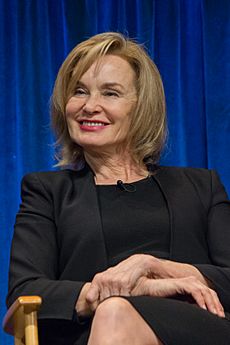
Patsy Cline has been shown in movies and on TV many times since the 1980s. The movie Coal Miner's Daughter (1980) renewed interest in her life. Patsy and Loretta Lynn's friendship was shown in the film. Actress Beverly D'Angelo played Patsy and sang her songs. D'Angelo was nominated for a Golden Globe Award for her role.
In 1985, a movie about Patsy's life called Sweet Dreams was released. Jessica Lange played Patsy, and Ed Harris played her husband Charlie Dick. The movie has been criticized for not being fully accurate to Patsy's life. But Jessica Lange's acting was praised. She was nominated for an Academy Award for Best Actress for playing Patsy.
Patsy was also in TV movies. In 1995, a movie about Dottie West called Big Dreams and Broken Hearts: The Dottie West Story showed West's friendship with Patsy. Actress Tere Myers played Patsy in this movie.
Lifetime aired a TV movie called Patsy & Loretta in October 2019. It tells the story of Patsy's friendship with Loretta Lynn. Megan Hilty played Patsy, and Jessie Mueller played Loretta. The movie was filmed in Nashville, Tennessee. It was co-produced by Loretta's daughter and Patsy's daughter, Julie Fudge.
Several documentaries have been made about Patsy's life. The Real Patsy Cline (1989) had interviews with friends and artists like Willie Nelson. Remembering Patsy (1994) was hosted by Michelle Wright. It featured letters Patsy wrote and interviews with artists like George Jones. Both documentaries were produced by Patsy's husband, Charlie Dick. In March 2017, PBS released a documentary on Patsy as part of their American Masters series. It was narrated by Rosanne Cash. It included interviews with fans like Reba McEntire.
Plays and Musicals
Patsy's life has also been shown in plays. In 1988, the show Always...Patsy Cline premiered. It was based on Patsy's friendship with a fan named Louise Seger. They met when Patsy performed in Houston, Texas. Seger took Patsy home, and they became friends. The play uses letters they exchanged. Louise Seger tells the story and shares memories.
Artistry and Influence
Musical Influences
Patsy Cline was influenced by many music artists. Early on, she was inspired by pop singers of the 1940s and 1950s. These included Kay Starr, Helen Morgan, Patti Page, and Kate Smith. Patsy's husband said she "adored" Patti Page and wanted to be like her. Kay Starr was a big influence on Patsy. Patsy also loved country music radio shows, especially the Grand Ole Opry. Her mother said Patsy wanted to be a star on the Opry more than anything. Patsy was also influenced by rockabilly artist Charline Arthur.
Voice and Singing Style
Patsy Cline had a deep, powerful voice called a contralto. Time magazine called her voice "bold." Her voice is also praised for showing a lot of emotion. One writer called it one of the most "emotionally expressive voices in modern country music." Patsy herself said, "Oh Lord, I sing just like I hurt inside."
In her early career, Patsy recorded gospel, rockabilly, and honky-tonk songs. These songs for Four Star Records are seen as not as good as her later work for Decca Records.
Patsy's style is strongly linked to the Nashville Sound. This was a country music style that mixed traditional lyrics with pop music sounds. This new sound helped many of her songs become popular on the Billboard Hot 100. This brought her music to a wider audience. Her producer Owen Bradley helped create this sound for her Decca recordings. He saw that her voice could go beyond traditional country music. At first, she did not like the pop sound, but she was convinced to record in this new style. Critics say Patsy helped define the Nashville Sound. Her voice made songs better, adding "new depth."
Public Image and Impact
Patsy Cline's public image changed over her career. She started by wearing cowgirl dresses and hats made by her mother. But as her music became popular in pop, she started wearing sparkly gowns and cocktail dresses. She would wear cowgirl outfits for live shows, but elegant dresses for TV and city performances. For her 1957 show on Arthur Godfrey's Talent Scouts, the producer wanted her to wear an evening dress instead of her cowgirl outfit. Her shows in Las Vegas in 1962 showed this change in image. She wore a sequined cocktail dress made by her mother.
Patsy Cline is also seen as a pioneer for women in country music. Many artists in different music styles say she inspired them. She was known for her "aggression" and "boisterous attitude." This earned her respect from male singers. She showed that women could sing about tough topics like divorce, as well as love. She helped prove that country music was not just for men. She showed that "strong women" could have a "strong voice." One writer said in 2013 that Patsy "didn't open doors; she kicked them down."
Legacy and Honors
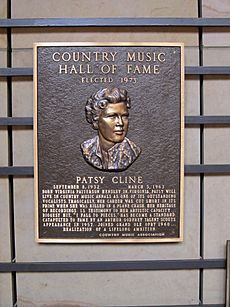
Patsy Cline is known as one of the greatest singers of all time in both country and pop. Her voice has been called "haunting," "powerful," and "emotional." Her emotional singing style influenced many music types and artists. With producer Owen Bradley, Patsy helped define the Nashville Sound in country music. Many artists have noted her impact. LeAnn Rimes said, "I remember my dad telling me to listen to the way she told a story... I remember feeling more emotion when she sang than anyone else." Lucinda Williams said Patsy's singing was more like a classic pop singer, which made her stand out.
Patsy Cline has been a major influence on artists like Reba McEntire, Loretta Lynn, LeAnn Rimes, k.d. lang, Linda Ronstadt, Trisha Yearwood, Sara Evans, Dottie West, Kacey Musgraves, Margo Price, Cyndi Lauper, Trixie Mattel and Brandi Carlile. Dottie West said Patsy influenced her most. She said Patsy told her, "Hoss, if you can't do it with feeling, don't." Sara Evans said she learned everything about Patsy as a young girl. She tried to copy her singing.
In 1973, Patsy Cline was inducted into the Country Music Hall of Fame. She was the first solo female artist to be included. In 1977, her friend Loretta Lynn released a tribute album called I Remember Patsy. It had covers of Patsy's songs. The song "She's Got You" from the album reached number 1 on the country chart in 1977. In 1995, Patsy received a Grammy Lifetime Achievement Award for her career. Her hits "I Fall to Pieces" and "Crazy" were also added to the Grammy Hall of Fame.
In 1993, Patsy Cline was featured on United States postal stamps. She was part of their "Legends" series. In August 1999, Patsy received a star on the Hollywood Walk of Fame. Her husband Charlie Dick and daughter Julie Fudge attended the ceremony. In the 1990s, two of her songs were voted among the "Greatest Juke Box Hits of All-Time." "Crazy" was voted number 1, and "I Fall to Pieces" was number 17.
Patsy has received more honors since the late 1990s. In 1999, she was ranked number 11 on VH1's list of the "100 Greatest Women of Rock and Roll." In 2003, Country Music Television included her on their list of the "40 Greatest Women of Country Music." In 2010, Patsy ranked number 46 on Rolling Stone's list of the "100 Greatest Singers of All-Time." In 2017, the magazine ranked her number 12 on their "100 Greatest Country Artists of All-Time" list.
Forty years after her death, MCA Nashville released a tribute album called Remembering Patsy Cline (2003). It had cover versions of songs from Patsy's 1967 greatest hits album. It included songs by country artists like Terri Clark and Martina McBride. It also featured artists from other genres.
Patsy's hometown of Winchester, Virginia has honored her legacy. In 1987, the town placed markers to show it as her birthplace. A bell tower was built at her burial site. In 2005, Patsy's childhood home was added to the National Register of Historic Places. An organization called Celebrating Patsy Cline Inc. helped fix up her childhood home. In August 2011, the Patsy Cline House opened as a historic home for tours. The home was restored to look like it did when Patsy lived there in the 1950s. It has replica furniture and stage clothes. Her daughter Julie Fudge said, "I think when you go into the house, you will kind of feel like this is a snapshot of what it would have been like to visit when Mom lived there."
In 2017, the Patsy Cline Museum opened in Nashville, Tennessee. It is in the same building as the Johnny Cash Museum. The museum has Patsy's actual stage costumes, her scrapbook, and record albums. It also has other items like the soda fountain machine from the drug store where Patsy worked as a teenager. Original letters Patsy wrote to friends are also in the museum.
Discography
Studio albums
- 1957: Patsy Cline
- 1961: Showcase
- 1962: Sentimentally Yours
Posthumous studio albums
- 1964: A Portrait of Patsy Cline
- 1964: That's How a Heartache Begins
- 1980: Always
Images for kids
See also
 In Spanish: Patsy Cline para niños
In Spanish: Patsy Cline para niños


